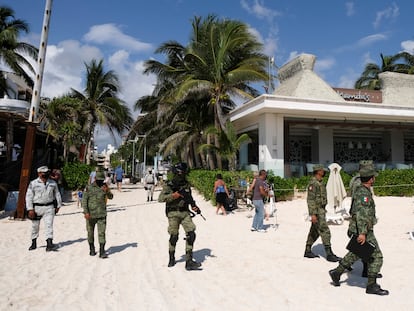Extortion and murder in the Riviera Maya: The dark side of Mexico’s tourist paradise
The heart of the Mexican Caribbean has been recording up a string of killings and shootings, while business owners in the region say organized crime groups are in charge


The Walczak family looks happy. The parents are drinking Coca-Cola on their sun loungers as they soak up the sun, and their little boy is playing in the sand. On the shore, a young woman has removed her bikini top to take a selfie with her back to the crowd of tourists on the beach. The Walczaks arrived in Playa del Carmen, on Mexico’s Caribbean coast, two weeks ago, fleeing the cold winter temperatures back in Poland. “Our Polish friends told us we should go to the Canary Islands instead [a Spanish archipelago off the coast of Africa]. They were worried about narco activity, but all we’ve seen so far are margaritas and mojitos,” says the mother in slightly broken English.
The Walczaks haven’t been watching the news lately, and they are not aware of what happened here just one week ago. Just a short distance away from this spot, inside the restrooms located between the bust of Buddha and the massage room, the manager of a trendy venue called Mamita’s Beach Club was found dead on January 26. He’d been shot at close range.
In fact it was three shots: one in the leg and two in the head, explains the woman lying in the next sun lounger. Claudia Suárez is a Mexican entrepreneur who lives in the capital but owns a summer house in Playa del Carmen, a fishing village that has become a popular tourist resort that also attracts many US visitors.
Mexican authorities are already speaking openly about the ever-greater presence of organized crime in the state of Quintana Roo. The heart of the Mexican Caribbean has been racking up a string of incidents that bear the hallmarks of drug gangs: killings, shootings and bodies left on the street as a message.
“The shot in the leg was a warning: either you pay or we kill you,” says Suárez, sounding quite familiar with the way criminal groups work. At Mamita’s, only a discreet black ribbon indicates that there was a murder here recently. “People come here to enjoy their vacation. That’s the way things are in Mexico: you go on as if nothing had happened.”
Mexico has indeed grown accustomed to daily violence. Official figures show in excess of 90 homicides a day, even higher than in the days of the war against drugs. But here in the Riviera Maya, violence seems little more than a discomfort to be largely ignored. Not even the steady drip of beachfront incidents – assassinations, gun fights, stray bullets – seems to be affecting tourist arrivals, which have recovered better than many other global destinations following the slump caused by the coronavirus pandemic. Last year, Cancún was the airport with the highest number of international arrivals after Dubai. There were over 12 million visitors, as if the entire population of Belgium had traveled to the Mexican state of Quintana Roo, which has two million registered residents.
Organized crime groups control everything. Drugs, alcohol, prostitution, massage parlorsEntrepreneur who wished to remain anonymous due to fear of reprisal
Authorities insist that the latest incidents are all isolated cases and note that they have already made a few arrests. But it is hard to keep tabs on all the activities – both legal and illegal – associated with the area’s busy daytime and night-time scene.
Politicians note that the state’s murder rate is still lower than the national average. In fact, figures have been on a slight downward trend for the last two years, but high-profile crimes by organized groups have been on the rise. This time, the focus is not so much on the city of Cancún as on the 200-kilometer (124-mile) stretch of road ending in the southern municipality of Tulum and passing by endless resorts, spas and private clubs.
The biggest problems are now located halfway down that road, in Playa del Carmen. Five days before the Mamita murder, two Canadian tourists were killed in a shootout at a hotel, and in early November armed men ran into the lobby of another hotel and killed two people.
President Andrés Manuel López Obrador sent 1,500 soldiers down to the area late last year. The uniformed troops can now be seen patrolling the beaches, including Playa del Carmen where authorities have arrested three people in connection with the murder of the bar manager. The hitmen have been described as alleged members of the Sinaloa drug cartel.
A few months ago the Quintana Roo police inaugurated a new surveillance center in Cancún that takes up half a soccer pitch and where workers keep an eye on the images delivered by over 2,000 cameras scattered across the state.
Lucio Hernández, the secretary for public safety in Quintana Roo, explains that the owners of Mamita’s had refused help from law enforcement because they thought they had a good relationship with “them,” meaning with the organized crime gangs that operate in the area. According to testimony from individuals who spoke on condition of anonymity, these mafias have local entrepreneurs in their hold and extortion is a rampant problem. Official statistics do not reflect the magnitude of the problem. “For every 100 cases we only get three or four reports,” admits Hernández. That is why authorities are incentivizing a system for making anonymous reports and trying to get undercover officers into local businesses.

One entrepreneur who refused to give out his name out of fear of reprisals confirms that organized crime is in charge around here. “They control everything. Drugs, alcohol, prostitution, massage parlors.... and they have threatened everyone,” says this individual, admitting that after holding out for several months, he finally agreed to pay the mafia 25,000 pesos a month (around $1,200 or €1,050) for each of his businesses. “Our relatives no longer come out of fear that they’ll be recognized and kidnapped. And authorities do nothing. We need surveillance and punishment.”
In the case of the Canadian tourists shot dead in Xcaret, a massive tourist development the size of 150 soccer fields, it turns out that the victims had criminal records back home and were part of a Canadian mafia group whose leaders hired Mexican hitmen to kill them over a disagreement, according to Mexican authorities.
“We are aware that members of international criminal groups are entering our territory,” says Hernández. Last year authorities detained the alleged leader of a Romanian gang that was operating in all the main tourist destinations in Quintana Roo, duplicating tourists’ credit cards.
As for the Mexican mafias, there are at least three in the area: Sinaloa, Cartel Jalisco Nueva Generación and what’s left of the Gulf cartel, which ruled the east coast of Mexico in the 1990s. Back then, the southern portion of Quintana Roo was one of the main nodes of the Caribbean route for Colombian cocaine making its way into the United States. The route is still operational to this day.
The development of Mexico’s Caribbean coast as a tourist mecca began in the mid-1970s. Cancún, its first major attraction, was “integrally planned” by tourism authorities to be erected in the middle of the jungle, surrounded by archeological remains. The Riviera Maya brand was created in 1998 with support from the hotel industry. The rise of the Caribbean as the new destination for international tourism coincided with the decline of Acapulco, where the Hollywood crowd had flocked to until the 1970s. Until then, it had been a favorite destination of the likes of Bette Davis, Rita Hayworth and Cary Grant. Acapulco’s star faded in part due to violence caused by organized crime. Now, local entrepreneurs in the Riviera Maya are starting to see the similarities: “Let’s hope we don’t turn into the new Acapulco.”
Tu suscripción se está usando en otro dispositivo
¿Quieres añadir otro usuario a tu suscripción?
Si continúas leyendo en este dispositivo, no se podrá leer en el otro.
FlechaTu suscripción se está usando en otro dispositivo y solo puedes acceder a EL PAÍS desde un dispositivo a la vez.
Si quieres compartir tu cuenta, cambia tu suscripción a la modalidad Premium, así podrás añadir otro usuario. Cada uno accederá con su propia cuenta de email, lo que os permitirá personalizar vuestra experiencia en EL PAÍS.
¿Tienes una suscripción de empresa? Accede aquí para contratar más cuentas.
En el caso de no saber quién está usando tu cuenta, te recomendamos cambiar tu contraseña aquí.
Si decides continuar compartiendo tu cuenta, este mensaje se mostrará en tu dispositivo y en el de la otra persona que está usando tu cuenta de forma indefinida, afectando a tu experiencia de lectura. Puedes consultar aquí los términos y condiciones de la suscripción digital.
More information
Últimas noticias
There is as much life left to discover on planet Earth as that which is already known
Dozens presumed dead, around 100 injured in fire at Swiss Alps bar during New Year’s celebration
Is porn for women different from conventional porn? We spoke to those who make it
Cartagena de Indias is sinking: What can the city do to mitigate it?
Most viewed
- David King, chemist: ‘There are scientists studying how to cool the planet; nobody should stop these experiments from happening’
- Reinhard Genzel, Nobel laureate in physics: ‘One-minute videos will never give you the truth’
- Oona Chaplin: ‘I told James Cameron that I was living in a treehouse and starting a permaculture project with a friend’
- Sinaloa Cartel war is taking its toll on Los Chapitos
- The Interoceanic Train, the Mexican alternative to the Panama Canal










































